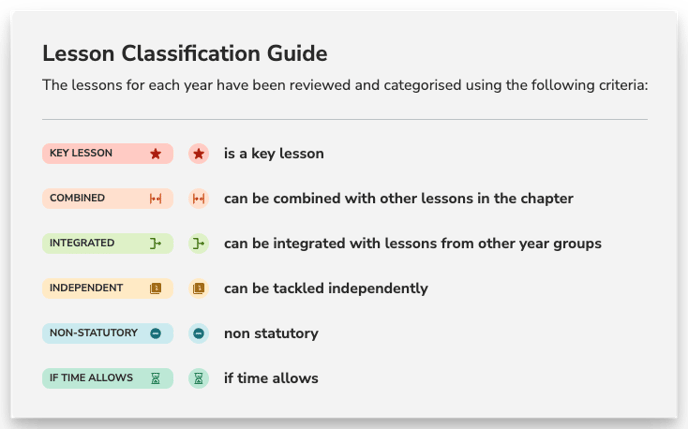This article will define the classification labels that are inside the Textbooks.
The lessons for each year have been reviewed and categorised using the following criteria:

Lesson Classification Overview
Here are the key terms broken down:
Key Lesson
A key lesson introduces something new like a new mathematical concept, method, language or image. All the sections of these lessons should be completed.
Combined
This encourages you to choose key elements from two lessons to make a combined lesson, instead of covering two complete lessons quickly. Lessons that can be combined tend to be key lessons. They can be combined because they both cover the same key concepts.
Independent
Some topics are more straightforward than others. For example, when they are more informational than conceptual. These lessons can be completed by pupils as independent study units outside of school instructional time. For example, Lessons 1 and 2 in Chapter 8: Shapes and Patterns.
Integrated
Some lessons or topics can be integrated into other curriculum areas. Take Chapter 16: Time, for example. Telling the time is something that can be included throughout the school day. You can use the words, ‘next’, ‘before’ and ‘after’ in daily conversations or when looking at a class timetable.
Non-Statutory
All lessons are a statutory requirement unless marked as non-statutory.
If time is an issue for you, prioritise the lessons that are statutory requirements. For example, Chapter 6: Numbers to 20, Lesson 5 on number patterns is not a statutory requirement. It is a valuable lesson but if you’re stretched for time, it can be omitted.
If Time Allows
Some of the lessons within a chapter might cover the same objective and in some cases not all of these lessons need to be completed if time is an issue. Leaving out problem-solving lessons is not as detrimental as leaving out lessons on core concepts. Head to Problem Solving vs Core Concepts in the next section to learn more.
